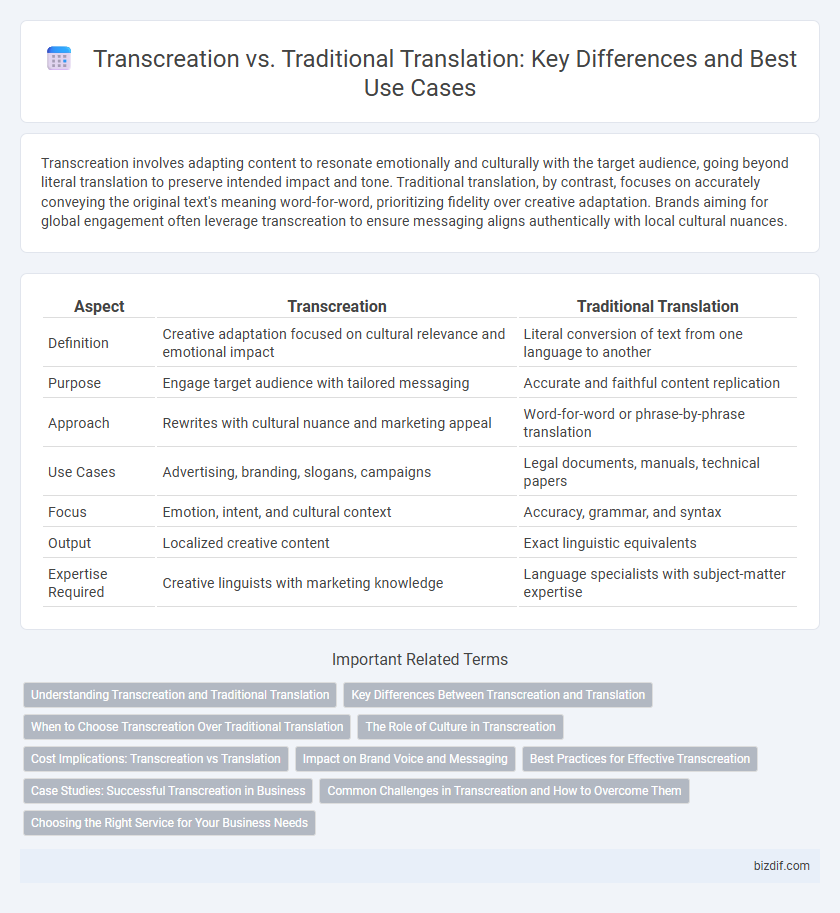Transcreation involves adapting content to resonate emotionally and culturally with the target audience, going beyond literal translation to preserve intended impact and tone. Traditional translation, by contrast, focuses on accurately conveying the original text's meaning word-for-word, prioritizing fidelity over creative adaptation. Brands aiming for global engagement often leverage transcreation to ensure messaging aligns authentically with local cultural nuances.
Table of Comparison
| Aspect | Transcreation | Traditional Translation |
|---|---|---|
| Definition | Creative adaptation focused on cultural relevance and emotional impact | Literal conversion of text from one language to another |
| Purpose | Engage target audience with tailored messaging | Accurate and faithful content replication |
| Approach | Rewrites with cultural nuance and marketing appeal | Word-for-word or phrase-by-phrase translation |
| Use Cases | Advertising, branding, slogans, campaigns | Legal documents, manuals, technical papers |
| Focus | Emotion, intent, and cultural context | Accuracy, grammar, and syntax |
| Output | Localized creative content | Exact linguistic equivalents |
| Expertise Required | Creative linguists with marketing knowledge | Language specialists with subject-matter expertise |
Understanding Transcreation and Traditional Translation
Transcreation involves creatively adapting content to maintain its original intent, emotion, and cultural relevance, often used in marketing and advertising to resonate with target audiences. Traditional translation focuses on accurately converting text from one language to another, prioritizing fidelity to the source material's meaning and structure. Understanding these differences helps businesses choose the right approach for global communication, ensuring message effectiveness across diverse markets.
Key Differences Between Transcreation and Translation
Transcreation emphasizes adapting content to resonate culturally and emotionally with the target audience, going beyond literal translation of words seen in traditional translation. It involves creative rewriting to maintain the original message's intent, tone, and context, especially in marketing and advertising materials. Traditional translation prioritizes accurate and faithful language conversion, focusing on grammar, vocabulary, and syntax without major alterations to the source text's style or messaging.
When to Choose Transcreation Over Traditional Translation
Choose transcreation over traditional translation when marketing campaigns require cultural adaptation to resonate emotionally with the target audience. Transcreation is essential for brand messaging, slogans, and advertising content where preserving tone, humor, and intent supersedes literal accuracy. Utilize traditional translation for technical documents, legal texts, and straightforward communications that prioritize clarity and precision.
The Role of Culture in Transcreation
Transcreation adapts content by integrating cultural nuances, idiomatic expressions, and local context to resonate deeply with the target audience, surpassing literal translation. Traditional translation tends to focus on direct linguistic accuracy, often neglecting cultural subtleties that affect meaning and emotional impact. The role of culture in transcreation is critical for ensuring messages maintain relevance and evoke the intended response within diverse cultural frameworks.
Cost Implications: Transcreation vs Translation
Transcreation generally incurs higher costs than traditional translation due to the creative process involved in adapting content for cultural relevance and emotional impact, which requires specialized linguistic and marketing expertise. Traditional translation typically involves direct language conversion, making it more cost-effective for straightforward content with minimal cultural adaptation. Businesses must weigh the investment in transcreation against potential returns in audience engagement and brand resonance when selecting between the two approaches.
Impact on Brand Voice and Messaging
Transcreation preserves the emotional resonance and cultural nuances of the original content, ensuring the brand voice remains consistent and impactful across diverse markets. Traditional translation often emphasizes literal accuracy, which can dilute brand messaging and reduce engagement with target audiences. Effective transcreation reshapes content to align with local cultural contexts, enhancing brand relatability and consumer trust.
Best Practices for Effective Transcreation
Effective transcreation requires deep cultural understanding and creative adaptation to preserve the original message's intent and emotional impact across languages. Leveraging native-speaking experts skilled in both language nuances and marketing ensures authenticity and resonance with the target audience. Consistent collaboration between translators, marketers, and client stakeholders enhances alignment with brand voice and campaign goals.
Case Studies: Successful Transcreation in Business
Successful transcreation in business often involves adapting marketing campaigns to resonate culturally and emotionally with target audiences, as demonstrated by Coca-Cola's "Share a Coke" campaign, which personalized product labels by local names and phrases, boosting global sales. Airbnb's localization strategy tailored content to reflect local customs and languages while preserving brand identity, resulting in increased user engagement and bookings across diverse markets. These case studies underscore how transcreation transcends literal translation by incorporating cultural nuances to enhance brand relevance and consumer connection.
Common Challenges in Transcreation and How to Overcome Them
Transcreation poses unique challenges such as preserving the original message's emotional impact while adapting cultural nuances and idiomatic expressions to resonate with the target audience. Overcoming these challenges requires a deep understanding of both source and target cultures, creative linguistic skills, and close collaboration between translators and marketing experts. Utilizing iterative feedback loops and leveraging translation memory tools can enhance consistency and effectiveness in transcreation projects.
Choosing the Right Service for Your Business Needs
Transcreation adapts content creatively to resonate with local cultures, making it ideal for marketing campaigns and brand messaging that require emotional impact. Traditional translation focuses on accurate, literal language conversion, best suited for technical documents and legal texts where precision is critical. Businesses should assess their communication goals and target audience to select the service that maximizes engagement and effectiveness.
Transcreation vs Traditional Translation Infographic

 bizdif.com
bizdif.com